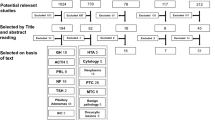Summary
The monoclonal antibody Ki-67 has been tested as a marker of proliferating cells in 52 stereotactic brain tumour biopsies. The antibody reacts with a nuclear protein expressed in G1,S, G2n and Mphases of the cell cycle. Using the immunoperoxidase technique on squash preparations the percentage of Ki-67 positive cells was determined as a fraction of the total number of tumour cells present. This Ki-67 index was in close correlation with the histological grade. Highest values were found in a pineal germinoma (46.3%) and in 3 primary cerebral non-Hodgkin lymphomas (mean 39.5%). Among the gliomas, the highest fraction of proliferating cells was seen in 2 anaplastic paediatric brain stem gliomas (mean 17.4%) and in an anaplastic ependymoma (12.5%). Anaplastic astrocytomas and glioblastomas varied considerably with mean values of 9.5% and 8%, respectively. To some extent this variability may reflect tumour heterogeneity which is more likely to manifest in small stereotactic samples than in large tissue specimens obtained during open surgery. Pilocytic astrocytomas, mixed gliomas and fibrillary astrocytomas had moderate to low percentages.
Ki-67 staining of squash preparations can easily be performed on a rountine basis and is, in our experience, superior to frozen sections. This method allows the determination of the growth fraction of an individual tumour and could become an important additional criterion for the decision among alternative and potentially harmful therapeutic regimens.
Similar content being viewed by others
References
Albright AL, Guthkelch AN, Packer RJ, Price RA, Rourke LB (1986) Prognostic factors in pediatric brain-stem gliomas. J Neurosurg 65: 751–755
Burger PC, Shibata T, Kleihues P (1986) The use of the monoclonal antibody Ki-67 in the identification of proliferating cells: application to surgical neuropathology. Am J Surg Pathol 10 (9): 611–617
Burger PC, Shibata T, Kleihues P (1987) Proliferation markers for neoplasms of the nervous system. Adv Immunol (in press)
Cho KG, Hoshino T, Nagashima T, Murovic JA, Wilson CB (1986) Prediction of tumor doubling time in recurrent meningiomas. J Neurosurg 65: 790–794
Gerdes J, Schwab U, Lemke H, Stein H (1983) Production of a mouse monoclonal antibody reactive with a human nuclear antigen associated with cell proliferation. Int J Cancer 31: 13–20
Gerdes J, Lemke H, Baisch H, Wacker HH, Schwab U, Stein H (1984) Cell cycle analysis of a cell proliferation-associated human nuclear antigen defined by the monoclonal antibody Ki-67. J Immunol 133: 1710–1715
Gerdes J (1985) An immunohistological method for estimating cell growth fractions in rapid histopathological diagnosis during surgery. Int J Cancer 35: 169–171
Giangaspero F, Doglioni C, Rivano M, Pileri S, Gerdes J, Stein H (1987) Growth fraction in human brain tumors defined by the monoclonal antibody Ki-67. Acta Neuropathol 74: 179–182
Gilles FH, Leviton A, Hedley-Whyte ET, Jasnov M (1983) Childhood brain tumor update. Human Pathol 14: 834–845
Hamilton E, Dobbin J (1985) The validity of the labeling index in tumor studies. Br J Cancer 51: 15–21
Hoshino E, Barker M, Wilson CB, Boldrey EB, Fewer D (1972) Cell kinetics of human gliomas. J Neurosurg 37: 15–26
Hoshino T (1984) A commentary on the biology and growth kinetics of low-grade and high-grade gliomas. J Neurosurg 61: 895–900
Hoshino T, Nagashima T, Murovic JA, Wilson CB, Edwards MSB, Gutin PH, Davis RL, Dearmond SJ (1986) In situ cell kinetics studies on human neuroectodermal tumors with bromodeoxyuridine labeling. J Neurosurg 64: 453–459
McComb RD, Bigner DD (1984) The biology of malignant gliomas-a comprehensive survey. Clin Neuropathol 3: 93–106
Nagashima T, Murovic JA, Hoshino T, Wilson CB, Dearmond SJ (1986) The proliferative potential of human pituitary tumors in situ. J Neurosurg 64: 588–593
Ostertag CB, Mennel HD, Kiessling M (1980) Stereotactic biopsy of brain tumors. Surg Neurol 14: 275–283
Zuber P, Hamou MF, de Tribolet N (1987) Identification of proliferating cells in human gliomas using the monoclonal antibody Ki-67 Neurosurgery (in press)
Author information
Authors and Affiliations
Rights and permissions
About this article
Cite this article
Ostertag, C.B., Volk, B., Shibata, T. et al. The monoclonal antibody Ki-67 as a marker for proliferating cells in stereotactic biopsies of brain tumours. Acta neurochir 89, 117–121 (1987). https://doi.org/10.1007/BF01560376
Issue Date:
DOI: https://doi.org/10.1007/BF01560376




